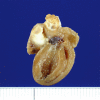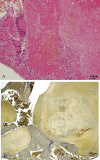Establishment of a model of spontaneously-running-Tokushima-shikoku rats with left atrial thrombosis
- PMID: 24791067
- PMCID: PMC4000073
- DOI: 10.1293/tox.2012-0032
Establishment of a model of spontaneously-running-Tokushima-shikoku rats with left atrial thrombosis
Erratum in
-
Errata (Printer's correction).J Toxicol Pathol. 2016 Jan;29(1):74. Epub 2016 Feb 17. J Toxicol Pathol. 2016. PMID: 26989306 Free PMC article.
Abstract
Studies that investigate the underlying mechanisms of disease and treatment options typically require the use of a suitable animal model. Few suitable animal models exist for left atrial thrombosis. Here, we demonstrated that the Spontaneously-Running-Tokushima-Shikoku (SPORTS) rat - a Wistar strain known for its running ability-is predisposed to the development of thrombi in the left atrium. We investigated the incidence of left atrial thrombosis in male (n = 16) and female (n = 17) SPORTS rats and observed organized atrial thrombosis in 57% and 38% of males and female rats, respectively. In the male rats, systolic blood pressures and heart rates were significantly higher in SPORTS rats than in control Wistar rats. We could not find any evidence of arrhythmias, such as atrial fibrillation, during electrocardiographic examination of SPORTS rats. We believe that the SPORTS rat could serve as a new research model for left atrial thrombosis; further, it may be suitable for research investigating the development of new antithrombotic approaches for the control of atrial thrombosis or familial thrombophilia in humans.
Keywords: atrial thrombosis; heart; rat.
Figures




References
-
- Leung DY, Davidson PM, Cranney GB, and Walsh WF. Thromboembolic risks of left atrial thrombus detected by transesophageal echocardiogram. Am J Cardiol. 79: 626–629 1997. - PubMed
-
- Egeberg O. Thrombophilia caused by inheritable deficiency of blood antithrombin. Scand J Clin Lab Invest. 17: 92 1965. - PubMed
-
- Rosendaal FR, Heijboer H, Briët E, Büller HR, Brandjes DP, de Bruin K, Hommes DW, and Vandenbroucke JP. Mortality in hereditary antithrombin-III deficiency - 1830 to 1989. Lancet. 337: 260–262 1991. - PubMed
-
- Ridker PM, Hennekens CH, Lindpaintner K, Stampfer MJ, Eisenberg PR, and Miletich JP. Mutation in the gene coding for coagulation factor V and the risk of myocardial infarction, stroke, and venous thrombosis in apparently healthy men. N Engl J Med. 332: 912–917 1995. - PubMed
-
- Aiach M, Borgel D, Gaussem P, Emmerich J, Alhenc-Gelas M, and Gandrille S. Protein C and protein S deficiencies. Semin Hematol. 34: 205–216 1997. - PubMed
LinkOut - more resources
Full Text Sources
Other Literature Sources
